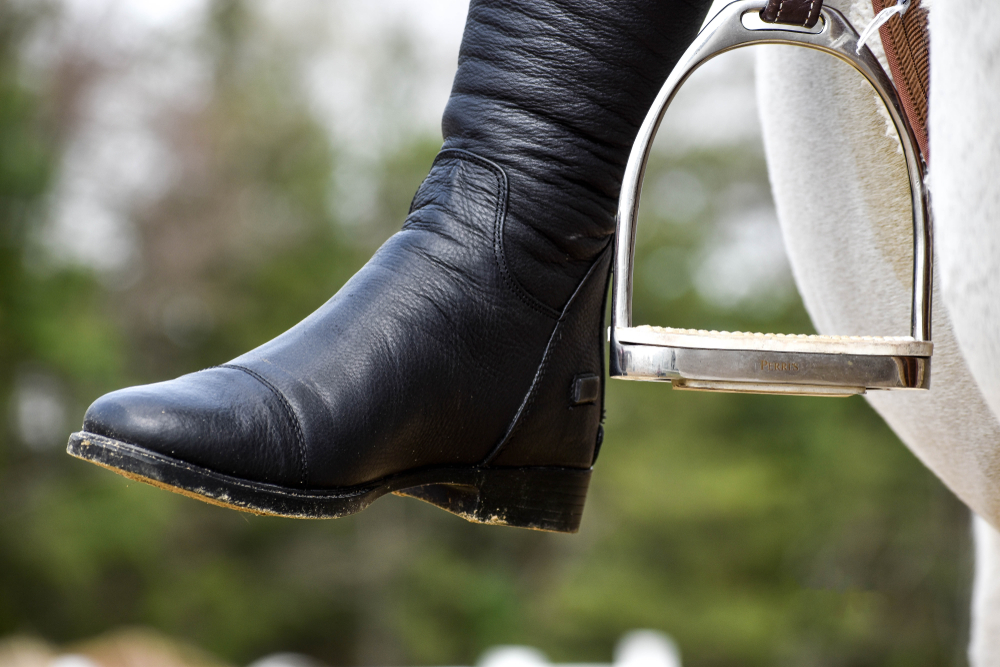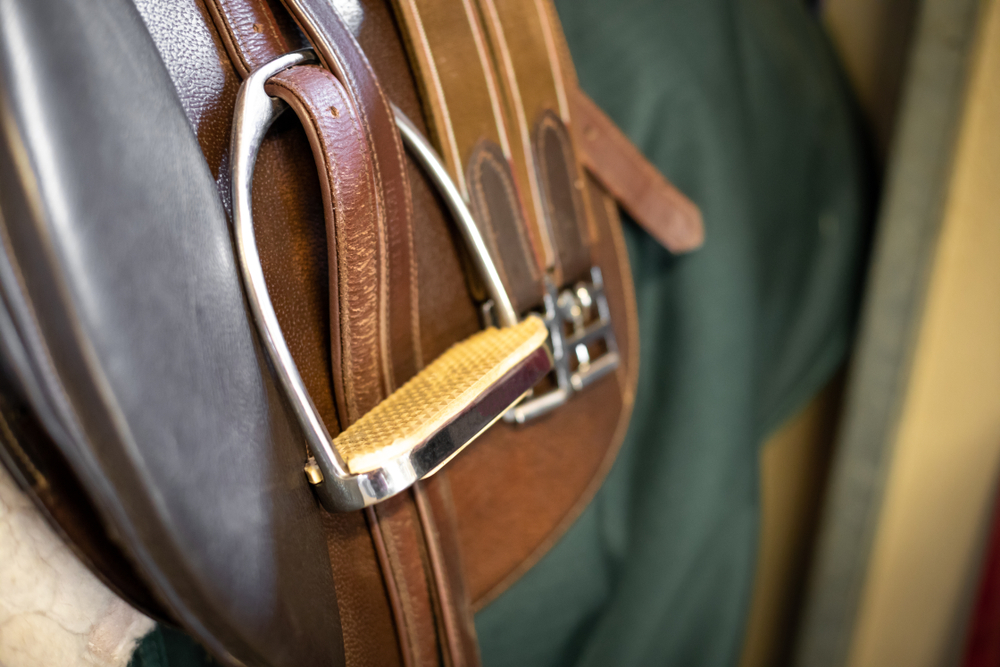- Your source for stall mats, rubber arena footing, arena harrows and arena dust control.

In jumping, there are many different sub-disciplines that can be done. I have been doing Showjumping, hunter, eventing, and equitation for many years now, and I have struggled to find the right stirrups. Jumping adds a lot of stress to your ankles due to the weight you put into your stirrups while going over jumps, so it is important to find the right stirrups.
The best stirrups for jumping are the ones that provide ankle and knee support, shock absorption, and stability to the rider. The stirrup should be lightweight, ergonomic, non-slip, and safe. One of the most favored stirrups is the Acavallo Opera Stirrups due to them having these qualities. Top show jumping riders have their own preference when it comes to stirrups.
With so many stirrups available at your local tack shops or even online, how do you know which one to choose? Sometimes it might seem overwhelming, but I will break it down to make it easier for you to choose your stirrups. Everyone will have their own preference when it comes to stirrups. For example, I prefer a stirrup that provides ankle support as my ankles tend to hurt when I am jumping.
What Are Stirrups?
Stirrup irons are flat-bottomed rings that hang down from the saddle via the stirrup leathers—the stirrup leather loop through the stirrup bars placed under the rider’s thigh. The stirrups are there for the rider to place their feet in for more security and balance in the saddle. They are used to mount the horse, stabilize the rider and offer a base of support for the rider to stand in the stirrups over jumps and while going light seat.
Although they are called stirrup irons, they can be made from many different materials designed for any rider’s needs. They vary from the traditional style to the more modern, sleek, and performance-enhancing styles.
The type of stirrups that you choose is essential as they impact your riding position and efficiency in the saddle. The rider’s comfort is also affected by the stirrups are the stirrups provide support for the rider’s full weight over obstacles and galloping over long distances.
Modern stirrups are also designed with safety in mind. Many catastrophic injuries result from a rider’s foot getting stuck in the stirrup during an accident and the rider being dragged behind a horse.
The Different Disciplines
It is not only in show jumping that one jumps over obstacles. Jumping over obstacles started centuries ago when horses were first ridden. The riders and hordes would jump over natural obstacles that might have been in their paths while traveling, exploring, war or hunting. In the 19th century, jumping became an admired equestrian and horsemanship skill.
Mid-19th century, jumping was used to settle wagers, and this has evolved into competitions, and it could be seen at fairs and horse competitions. It became a large public interest to watch high a broad jumping. In the first recorded jumping competitions, the aim was to see who could jump the highest or the widest. Most jumpers were called Hunters for decades.
Late 19th century, the hunters and high jumpers started to separate. The high jumpers went over 7-foot fences in competitions, and hunters focussed on lower courses over longer distances.
Types of Stirrup Irons
When watching a jumping competition, you will see many different designs and styles of stirrup irons. Each rider will have their own favorite stirrups that they feel provide them with the most comfort, balance, and support while jumping.
Traditional Fillis Irons
Fillis is the most common and simple type of stirrups. These are cheap stirrups that are most commonly used in basic day-to-day riding. Fillis is made of stainless steel with a rubber pad at the bottom.
Peacock safety stirrups
The peacock stirrups have the same design are the traditional fillis, but they have a quick-release mechanism for safety measures. The quick-release rubber sits on the outer-most part of the foot and is, therefore, in case the rider falls off. The rubber snaps off and allows the rider’s foot to slide out of the side of the stirrup so that they do not get stuck.
These stirrups are more commonly used in riding schools and competitions where falls are more frequent.
Flexi stirrups
Flexi stirrup irons are another variation from the fillis. The sides of the stirrups are pliable and bendable to allow more movement with the rider. When the rider steps down into their heels, the flexi irons bend to allow the rider’s ankle to move down and allow for more comfort. If you struggle with joint pain or stretching your ankles down, I would not recommend these stirrups as I have found that these increase my pain due to the overloading on my ankles when jumping.
These stirrups are more suitable for dressage because of the flexibility and movement they allow for.
Composite
Composite stirrups are made of polymer material, aluminum, or titanium to make the stirrup more lightweight. Composite stirrups provide a wider base that has non-slip soles. These types of stirrups can provide more support for the rider’s ankles and knees. These types of stirrups come in many types of styles and shapes that the rider can choose from. Jumpers often favor lightweight stirrups with non-slip threads.

Top Five Stirrups for Jumping
Acavallo Opera Stirrups
A newer concept of stirrups but an overall favorite. The patented loop for the stirrup leather allows the stirrup to adhere to the saddle, causing a correct and comfortable leg position. The tread or base is wide and has enough grip for security. The tension on the ankles, knees, and hips is lessened due to the design; It is a composite material with stainless steel on the inside for ultimate strength.
FreeJump stirrups
My personal favorite, the free jump stirrups, are super lightweight with a broad, non-slip base that provides enough support for my ankles not to get sore. The outer brand of the stirrup is flexible to add to safety. The base is also on an incline to accommodate the rider’s heels to stay down without adding the necessary strain. The non-slip base helps the rider not lose their stirrups over jumps.
Lorenzini Titanium Stirrups
The Lorenzini stirrups are lightweight and ergonomically designed. The design also allows for the rider’s foot to slip out in case of an accident. The base is wide and non-slip, which also makes it great for jumping and support.
Korsteel Aluminium Stirrups
Another favorite of mine, these stirrups are made of Aluminium. They are lightweight, non-slip, and comfortable. They come in different colors as well – Hello matchy-matchy! The tread is high-traction and wide for ultimate comfort.
Royal Rider Flexible Stirrups
Royal rider stirrups are flexible stirrups with a stiffer flex to provide a bit more comfort and less strain on the ankles. They are polymer composite stirrups and are thus super lightweight. These stirrups also provide shock absorption for the higher jumping classes.

Conclusion
The rider will have to go through trial and error when it comes to choosing their favorite stirrups. The stirrups will greatly affect the rider’s position, comfort, stability, and overall enjoyment of their ride. There are many styles, models, and colors to choose from, and it will ultimately come down to preference and the price that the rider can pay for their stirrups.
References
https://horsenetwork.com/2020/12/the-essential-history-of-show-jumping/
https://horserookie.com/best-stirrups-for-jumping/
https://equineigh.com/best-stirrups/
https://www.acavallo.com/ac_product/opera-stirrup/
https://thehaybarn.wordpress.com/2017/09/10/high-end-jumping-stirrups/




